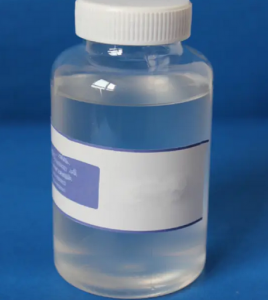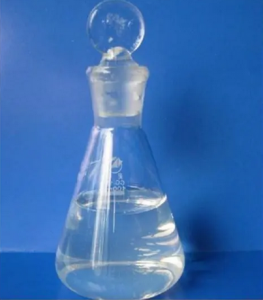
-
Heptamethyldisilazane(HPMDZ) CAS NO.920-68-3 as Silicone origin from China.
Name: Heptamethyldisilazane CAS No.: 920-68-3 Molecular formula: C7H21NSi2 Molecular weight: 175.42 UN Number: 2924 Product standard: HG/T 5797-2021 Appearance: Colorless transparent liquidTags : Heptamethyldisilazane(HPMDZ) CAS NO.920-68-3 Heptamethyldisilazane CAS NO.920-68-3 HPMDZ CAS NO.920-68-3 N,1,1,1-tetramethyl-N-(trimethylsilyl)silylamine CAS 920-68-3 HPMDZ CAS 134340-00-4 HPMDZ CAS 37074-17-2
-
2-Hydroxy Ethyl Methacrylate CAS: 868-77-9
Hydroxyethyl methacrylate (HEMA) is a non-toxic, harmless, and widely used reagent, commonly used for soft lens materials, lens materials, or as a monomer for preparing dense ceramics and glass. Polyhydroxyethyl methacrylate (PHEMA) is a promising biopolymer with significant inertness, biocompatibility, and insolubility. Method 1: Place 100 ml of toluene, 62.1 (1 mol) parts of ethylene glycol, and enzymes (Novozym 435, 0.04 parts, 0.01 parts of sodium carbonate, and 0.01 parts of hydroquinone manufactured by Novo) into a 1-liter glass flask connected to a cooling tube receiver (for measuring moisture) and a reflux side tube, and heat to 40 ° C. 72.1 parts (1mol) of acrylic acid were added in batches within 10 minutes, while stirring step by step. After completing the total addition, the mixture was stirred at the same temperature under reduced pressure of 10mPa. After the reaction, the target acrylate was obtained by filtering and separating the catalyst and additives. The time required for the reaction is approximately 6 hours. The yield and composition of the obtained acrylate were determined by gas chromatography (hereinafter abbreviated as GC). [0044] [Example 2] [0045] Except for changing 72.1 parts (1 mol) of acrylic acid to 86.1 parts (1 mol) of methacrylic acid in Example 1, the target compound was obtained in a similar manner to Example 1. The time required for the reaction is approximately 5 hours. The yield of hydroxyethyl methacrylate (HEMA) was 98.5% by gas chromatography. The synthesis is continuous as shown in Figure 1. Method 2: Add 31.05g ethylene glycol (EG, 0.5mol), 47.35g (0.55mol) methacrylic acid, 40g (inside, 22g water in the catalyst before use, 18g dry weight) strong acid ion exchange resin (Amberlite IR124: gel type, 12% cross-linking degree, no pore), 0.086g HO-TEMPO, 0.086g hydroquinone and 200g toluene into a 500ml glass flask equipped with Dean Stark device, cooling pipe, thermometer and air inlet pipe, Then heat and stir at 100 ℃, while using a pump to add water at a rate of 2g/h. The water formed in the reaction is azeotropic with toluene and removed through the Dean Stark device. After 5 hours, the conversion rate of hydroxyethyl methacrylate was 87.3%. The synthesis is continuous as shown in Figure 1. purpose Hydroxyethyl methacrylate is mainly used for modifying resins and coatings. Copolymerization with other acrylic monomers can produce acrylic resins with active hydroxyl groups in the side chains, which can undergo esterification and crosslinking reactions, synthesize insoluble resins, improve adhesion, and can be used as fiber treatment agents. It reacts with melamine formaldehyde (or urea formaldehyde) resin, epoxy resin, etc. to manufacture two component coatings. Adding it to high-end car paint can maintain the mirror gloss for a long time. It can also be used as an adhesive for synthetic textiles and as a medical polymer monomerTags : 2-Hydroxy Ethyl Methacrylate CAS: 868-77-9 C6H10O3 HEMA
-
2-Hydroxypropyl methacrylate
nature Hydroxypropyl methacrylate (HPMA) is a commonly used polymer material. 1. Appearance: The appearance of hydroxypropyl methacrylate is a colorless transparent liquid 2. Solubility: Soluble in water and also in most organic solvents, such as alcohols, ethers, esters, and aromatics. 4. Density: The density of hydroxypropyl methacrylate is 1.11-1.18 g/cm3. 6. Chemical stability: It has good chemical stability, is not easy to decompose, and will not react with most chemical substances. 7. Thermal stability: Hydroxypropyl methacrylate has good thermal stability, and its thermal stability is relatively high at high temperatures. 8. Oxidation stability: It has a certain resistance to oxidation and is not prone to oxidation and deterioration. Preparation 1. Add initiators such as hydroxypropyl methacrylate (HPMA) and hydrogen peroxide to the reactor, as well as an appropriate amount of solvents (such as methanol, ethanol, etc.). 2. Seal and shake the reaction kettle or heat it to react, causing the initiator to crack at an appropriate temperature, resulting in free radical polymerization of HPMA. After the reaction is completed, precipitate or precipitate the product with acidic water or organic solvents. 4. Filter and collect the product, wash and dry to obtain the pure product. The above is a simple preparation process for hydroxypropyl methacrylate, and the specific operating parameters and process flow may vary depending on different preparation methods and requirements. application 1. Paint and ink industry: it can be added to paint and ink as lotion and diluent to improve its viscosity, rheology and adhesion. 2. Cosmetics: Can be used in cosmetic products, such as hair gel, curling agents, sunscreen, etc., to thicken, moisturize, and prevent sun damage. 3. Daily necessities: It can be added as a thickener to daily necessities, such as detergents, facial cleansers, toothpaste, etc. 4. Pharmaceutical field: It can be used in drug sustained-release systems, such as artificial joint lubricants or eye drops for injection. In the future, with the continuous development of technology, the application prospects of hydroxypropyl methacrylate will become increasingly broad. For example, in the fields of biomedicine and drug delivery, cell delivery, and the preparation of nanomaterials, polymer materials such as hydroxypropyl methacrylate are also useful -
MONOHYDRATE DEXTROSE CAS NO.5996-10-1
Name: MONOHYDRATE DEXTROSE CAS No.: 5996-10-1;14431-43-7 Appearance: White or off white crystalline powder Molecular formula: C6H14O7 Molecular Weight: 198.1712 Density: 1.54 Melting point: 83°C Boiling point: 410.8°C at 760 mmHg Flash point: 202.2°C Vapor pressure: 1.83E-08mmHg at 25°CTags : D-Glucose monohydrate MONOHYDRATE DEXTROSE DEXTROSE DEXTROSE CAS NO.5996-10-1 DEXTROSE USP MONOHYDRATE Odorless
-
Acesulfame Potassium 55589-62-3
Product details Acesulfame Potassium CAS NO.55589-62-3 as Food Additives origin from China. Anhui Sinotech company strictly select GMP products, support customer registration , and provide professional services to chemical customers in the global market. Purchase Acesulfame Potassium CAS NO.55589-62-3, inquiry Anhui Sinotech.Tags : Acesulfame-K Acesulfame Acesulfame-K 55589-62-3 Sweeteners Food Additives Acesulfame CAS NO.55589-62-3
-
Citric acid monohydrate CAS:5949-29-1
Product details Citric Acid Monohydrate CAS:5949-29-1 as Food Preservative origin from China. Anhui Sinotech company strictly select GMP products, support customer registration , and provide professional services to chemical customers in the global market. Purchase Citric Acid Monohydrate CAS:5949-29-1,inquiry Anhui Sinotech . Name: Citric Acid Monohydrate CAS No.: 5949-29-1 Appearance: Colorless crystal or white crystalline powder Molecular formula: C6H10O8 Molecular Weight: 210.1388 Melting point: 135-152℃ Boiling point: 309.6°C at 760 mmHg Flash point: 155.2°C Water soluble: 1630 g/L (20℃) Vapor pressure: 5.73E-05mmHg at 25°C molecular structure: Description: Citric Acid Monohydrate CAS:5949-29-1 is an organic compound with a molecular formula of C6H10O8. It is mainly used in food and beverage industry as an acid flavor agent, flavoring agent, preservative and fresh-keeping agent. It is also used as antioxidant, plasticizer and detergent in chemical industry, cosmetics industry and washing industry. Application: Specification: CERTIFICATE OF ANALYSIS ITEM UNIT STANDARD DATA ACTUAL DATA DESCRIPTION --- COLOURLESS, CRYSTALS, WHITE AS STANDARD IDENTIFICATION & SOLUBILITY --- PASS TEST PASS TEST CLARITY & COLOR OF SOLUTION --- PASS TEST PASS TEST CONTENT % 99.50– 100.5 99.60 WATER % ≤ 8.8 8.40 BARIUM --- PASS TEST PASS TEST CALCIUM --- ≤ 200 ≤ 200 IRON PPM LESS THAN 10 <5.0 ARSENIC PPM LESS THAN 1 <1.0 HEAVY METALS PPM LESS THAN 5 <5.0 OXALATE PPM LESS THAN 100 <100 CHLORIDE PPM LESS THAN 50 <10 READILY CARBONISABLE SUBSTANCES --- PASS TEST PASS TEST SULPHATED ASH % LESS THAN 0.05 <0.05 SULPHATE PPM LESS THAN 150 <10 Package:Tags : Citric Acid Monohydrate BP
-
Sodium Cyclamate NF13 CAS NO.:68476-78-8
Name: Sodium Cyclamate CAS No.: 139-05-9;68476-78-8 Appearance: white crystalline powder Molecular formula: C6H12NNaO3S Molecular Weight: 201.2191 Melting point: 265℃ Water-solubility: >=10 g/100 mL at 20℃ molecular structure:Tags : sodium cyclohexanesulfamate cyclamic acid sodium crystalline Sodium N-cyclohexylsulfamate Beet Sugar Molasses sodium cyclohexylsulfamate Sodium Cyclamate
-
Wholesale Bulk Acid Violet 90 CAS 6408-29-3
Name: ACID VIOLET 90 CAS No.: 6408-29-3;1007172-44-2 Appearance: Dark red powder Molecular formula: C20H15N4NaO5S Molecular Weight: 446.41 EINECS:229-052-4 Package: 25KG/Carton Port of dispatch: SHANGHAI,QINGDAO MOQ: 1000KGTags : Acid violet 90 (C.I. 18761) CAS 6408-29-3 industrial ACID VIOLET 90 CAS 6408-29-3 Wholesale Violet 90 CAS 6408-29-3 Bordeaux MB Chinese supplier CAS 6408-29-3 Ambilan Bordeaux MB CAS 6408-29-3 Factory wholesale Industrial dyes ACID VIOLET 90 CAS 6408-29-3
-
Polyol ester compressor oil
Excellent thermal stability Low volatility Excellent low-temperature characteristics Excellent lubricity Biodegradability Package: 200KG/DRUM Tests Units Specification Analysis Results Acid Value mgKOH/g 0.10 Max 0.01 Water Content Wt% 0.05 Max 0.03 Colour APHA 200 Max 80 Kinematic Viscosity cSt(40℃) 21.6~26.4 22.9 Kinematic Viscosity cSt(100℃) 4.75~5.15 4.90 Viscosity Index ------ ------ 143 Pour Point ℃ -57 Max -60 Flash Point ℃ 225 Min 258 Package:Tags : Industrial lubricating oil Biodegradable polyol ester Compressor oil lubricating oil Polyol ester
-
Coolant of immersion cooling system
Kinetic viscosity= 5 cSt@20℃ Excellent heat transfer and insulating performance Low operation temperature Biodegradable and no harm to environment Low volatilityTags : Insulating Cooling Fluids Insulating Cooling Fluid for immersion cooling system Cooling Fluid Insulating Cooling Fluid immersion cooling system Coolant of immersion cooling system
-
Wholesale Bulk Propiconazole CAS NO.60207-90-1
Name:Propiconazole CAS No.:60207-90-1 Appearance: Light yellow to light brown viscous liquid Molecular formula: C15H17Cl2N3O2 EINECS No.: 262-104-4 Molecular Weight: 342.2204 Density: 1.39g/cm3 Boiling point: 479.9 ° C at 760 mmHg Flash point: 244.1 ° C Steam pressure: 2.26E-09mmHg at 25 ° C Water solubility: water solubility is 110mg/LTags : propiconazole suppliers CAS 60207-90-1 Propiconazole raw material supply Manufacturer of propiconazole CAS 60207-90-1 Propi CAS 60207-90-1 Propiconazole fungicide CAS 60207-90-1 Triazole fungicide propi CAS 60207-90-1
 call us :
call us :  send a message :
send a message : 





























 online service
online service +8613866722531
+8613866722531

 +8613866722531
+8613866722531